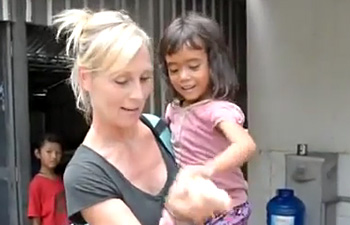By Ken Camp
Stephanie Henry — a survivor of childhood sexual abuse — became a stripper when she saw her body as a “commodity” that could provide relief from financial desperation. Today, she devotes her life to combating human trafficking and attitudes that objectify girls and women.
“I am doing this so I can heal, too,” Henry recently told a group of professionals and volunteers who work with teenagers.
Trafficking treats girls and women as commodities when they are forced or coerced into renting out their bodies, often for diminishing returns the more “used” they are, she notes.
 Henry, who leads the Activism for Empowerment Foundation, has worked to combat trafficking in Kenya, Nigeria and Cambodia. But she emphasizes trafficking occurs in American communities as well.
Henry, who leads the Activism for Empowerment Foundation, has worked to combat trafficking in Kenya, Nigeria and Cambodia. But she emphasizes trafficking occurs in American communities as well.
That places a heavy responsibility on the faith community, she said.
“Churches are where people often go for help. Every single solitary church should go through trafficking education,” she insists.
People who work with youth should recognize some of the warning signs of trafficking, such as a controlling older boyfriend, scars or bruises, stunted growth and truancy, she notes.
Push factors
Henry points to “push factors” that can lead girls and young women to become victims of trafficking — poverty, child sex abuse, early exposure to violence, family dysfunction and lack of education. One of three children who runs away is lured into sex trafficking within 48 hours of leaving home, she reports.
Henry relates to that profile. She grew up with abuse — molested by a great uncle, raped by a stepbrother and neglected by her mother. At age 13, a 19-year-old boyfriend introduced her to drugs and then took advantage of her sexually. By her junior year in high school, she developed an eating disorder, fueled by self-loathing and finding a false sense of control in binging and purging.
 She married at 18, and by 20, she had a baby and a full-blown case of post-partum depression. Before long, she entered an extramarital relationship. When she went to a pastor for counseling, he made sexual advances toward her.
She married at 18, and by 20, she had a baby and a full-blown case of post-partum depression. Before long, she entered an extramarital relationship. When she went to a pastor for counseling, he made sexual advances toward her.
She divorced her husband, and her life continued to spiral downward as she entered one abusive relationship after another, had two abortions and developed deep dependency on drugs and alcohol. She lost custody of her daughter, lost her will to live and lost any remaining self-respect.
She worked seven years as a stripper — a job that “would perfect my ability to shut my emotions down and perform for those who wanted to exploit me for their pleasure,” Henry wrote in her memoir, If Only I Could Sleep. “There’s a whole underground world of bars that open when regular bars are closing, and that’s the world I entered. … This was when I realized the body could actually be a commodity.”
At a residential treatment facility, she learned a life-changing lesson — accepting responsibility for herself.
“There is no way we can go back and make the monsters of our past accountable for what they do to us. They face their own judgment day. And make no mistake, they will have that day,” she wrote in her memoir.
“But we have to understand that the abuse put upon us was not about the real person we are, the person God intended us to be. We weren’t created for the abuses of this world, but if we have endured them and we can use that experience to help others, then we have survived.”
A short step away
In an interview, Henry noted financial desperation led her to work in a sexually oriented business, but some women performed to make money for controlling boyfriends — a short step away from trafficking.
“There was one time I remember when girls were taken right off the stage and out onto the street” to work as prostitutes, she recalled. “There but for the grace of God …,” she said, her voice trailing off.
Henry’s story fits the profile of many victims of trafficking, said Tomi Lee Grover, founder of TraffickStop.
“Sexual abuse is probably the No. 1 indicator of a child who has the potential of being exploited. Of the girls who have been rescued, probably 85 percent of them said they were sexually abused as children,” said Grover.
Although some nightclub owners try to make sure trafficking does not occur at their establishments, trafficking remains indisputably linked to at least some strip clubs and other sexually oriented related businesses, she said.
“It’s a slippery slope when people start working in that business. There are a lot of predators who come to prey upon them in that business and move them to prostitution,” she said.
Targets
While controversy surrounds the connection between sexually oriented businesses and trafficking, many young women working in strip clubs undoubtedly are targeted and recruited by pimps and traffickers, said Lindsey Speed, marketing and communication director for Traffick911, a Fort Worth, Texas-based organization that seeks to prevent trafficking and to rescue and restore underage victims of domestic sex trafficking.
“We have worked with a number of victims who started out trying to make money at places like this, or who got recruited to work there, and ended up being lured or forced to have sex or perform other acts against their will — and for money they never see,” Speed said.
Sexually oriented businesses create the demand sex traffickers supply, she added.
“At Traffick911, we believe that the sex industry as a whole is a circle, each area fueling another,” Speed said. “Whether it’s pornography, strip clubs, video stores, massage parlors, etc., these businesses are fueling sex addicts who have a continual lust for more. This is the essence of sin, right? When pornography doesn’t satisfy, they may turn to going to a strip club. When that doesn’t satisfy, they may turn to buying a woman or girl.”
In the United States, girls enter trafficking — on average — at age 12 or 13, she noted. That points to the need for churches to educate youth and those who are in contact with them, she added.
“Knowledge is power,” she said. “Education leads to prevention and rescue.”
